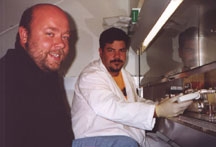
School:
Grade Level:
Teaching Position:
Supervisor:
Department:
Mentor:
Research Project Year:
Research Project Title:
Research Project Description:
Peptide-ligands incorporated in the structure of amphiphilic molecules undergo very specific lock and key reactions with receptors located within a cell's membrane. They are therefore able to mimic the extracellular matrix. With the successful docking of appropriate synthetic ligands at the cell's surface, a multi-step cascade of reactions within the cell results in cell attachment and spreading to surfaces that have been modified with such molecules. Within the Tirrell group, my research specifically involved:
1. Recording isotherms for various ratios of amphiphiles (MDA) and peptide-modified MDA-PA amphiphiles measured on the Langmuir-Blodgett trough.
2. Recording the isotherms with CaCl2 in varying concentrations added to the sub-phase
3. Maintaining a healthy mouse fibroblast cell line, including splitting the cell cultures when they reached confluence
4. Preparing mica and silicon wafer substrates for treatment with peptide amphiphiles
5. Photographing and counting mouse fibroblast cells on mica surfaces treated with different MDA-PA ratios to determine percent cell attachment and spreading.
We found that as the concentration of MDA-PA on our mica surfaces was increased, cell adhesion and spreading significantly improved. In other words, the cells were fooled into believing that they were within their natural environment. Experiments such as these will continue to examine the interactions of living cells with their environment, and move science closer to seamlessly incorporating synthetic or other abiotic materials into living systems.
